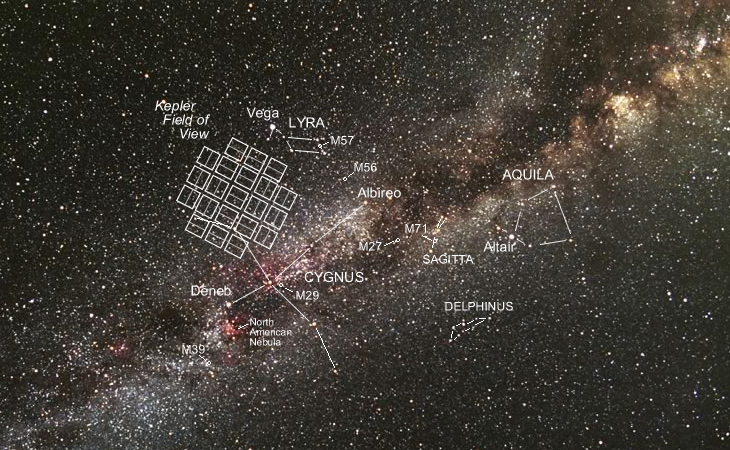A New Breed of Planet Hunters

The field of view for the Kepler spacecraft, which is collecting data for the search for exoplanets.
Carter Roberts
By: Brian Jacobsmeyer
(ISNS) -- Over the past decade, scientists have found evidence of hundreds of planets orbiting stars outside our solar system. A group of volunteers has also joined the search, and they have found several additional planets that initially fell through the cracks.
Exoplanets can be detected through a variety of ways, and scientists have increasingly looked for small, regularly repeating dips in light from a star-- a sign of planets passing in front of, or transiting, their home star. This same phenomenon happened in our own solar system earlier this month when Earth-based viewers saw Venus transit the sun for the last time this century.
But the sheer number of exoplanets means there's plenty of transits to track; consequently, scientists have acquired huge amounts of data to process. That’s partly why a research team at Yale University has recruited over 150,000 volunteers to help sort through publicly released data from the Kepler space telescope.
Called Planet Hunters, the project has led to the discovery of several new planets while also confirming many findings made by Kepler scientists. Earlier this year, project leaders unveiled two new exoplanet candidates that NASA’s computer data crunching failed to detect.
Most recently, 24,000 of the volunteers helped find seven more exoplanets that computer algorithms initially missed. Although updated data-processing algorithms detected these planets, scientists working to refine the algorithms have found the citizen volunteers' contributions invaluable.
"Firstly, it's educational and engaging. More importantly, it's having a real scientific impact," said Thomas Barclay, a research scientist at the NASA Ames Research Center who works on the algorithms used to find exoplanets with Kepler data.
After a brief tutorial, Planet Hunter volunteers can peruse light curves -- graphs of a star's light intensity -- with 30 days of Kepler data on the project's website. When enough planet hunters flag a potential planet candidate, the project scientists review this pared down data before formally recognizing a new alien world.
Although planet candidates detected by algorithms are eventually scrutinized visually, relying entirely on visual detection from the beginning has its advantages. Planet Hunters can identify planets with subtle orbital meanderings that may fly under a computer program's radar.
For instance, neighboring planets can tug on an exoplanet, leading to slight changes in its orbit around a star, and algorithms might miss this difference. Also, planets revolving around binary stars -- a set of two stars that orbit each other -- can be easier to detect by sight rather than with algorithms.
"You can never underestimate how important the human eye is at finding things," said Barclay.
Even the relatively untrained eye can be an effective planet detector. Volunteers of all ages have contributed to the Planet Hunters project, including participants as young as 13. Don’t be fooled by the volunteers' lack of experience, however. Citizen scientists detected 85 percent of large exoplanets in the data, according to a recent analysis accepted for publication in the Astrophysical Journal.
To test the efficiency of the planet hunters, the project leaders injected simulated exoplanet transits into the Planet Hunters datasets, unbeknownst to the volunteers. Because the scientists knew these simulations looked like actual transits, they could evaluate the volunteers’ detection ability.
While the citizen scientists found most large exoplanets, they had more difficulty detecting smaller Earth-sized planets. Algorithms are better at finding tiny dips in light from smaller planets when visual detection isn’t sensitive enough.
"There's a niche for Planet Hunters," said Meg Schwamb, an astrophysicist at Yale University and lead author of Planet Hunters' most recent analysis. "We're very sensitive to large planets."
As scientists and citizens both race to find exoplanets with similar sizes and orbits to Earth, they'll be using a variety of methods. Before scientists detected the first transiting exoplanet in 1999, they looked for slight wobbles in distant stars that indicated a planet was exerting a very small gravitational pull, and this method has remained popular.
Telescopes can now directly image exoplanets as well, and this method will become more important in coming years according to Jonathan Fortney, an exoplanet researcher at the University of California Santa Cruz. Even if new detection methods flourish, however, Fortney believes Planet Hunters will continue to contribute valuable findings.
"I think the citizen science stuff is incredibly interesting, especially in astronomy," said Fortney. "There’s a big amateur community."
Regardless of the method used, scientists are anxiously awaiting confirmation of a cosmic home away from home. Planet Hunters may not be the first group to find a truly Earth-like planet outside of our solar system, but scientists are using every tool available.
"I think we're only a year or 18 months away from finding an Earth analog," said Barclay. "We're getting very close."
Brian Jacobsmeyer is a contributing writer for Inside Science News Service.
